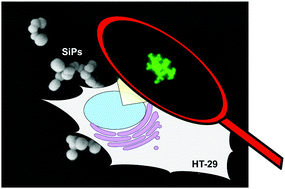Silica particles with a quercetin–R5 peptide conjugate are taken up into HT-29 cells and translocate into the nucleus†
Abstract
Intracellular delivery of bioactive polyphenols is currently evaluated as a protective strategy for cells under pharmaceutical stress. To this end, the 20mer R5 peptide from the marine diatom C. fusiformis was N-terminally modified with a quercetin derivative. This polyphenol–peptide conjugate was used to generate homogeneous silica particles under biomimetic conditions that are efficiently taken up by eukaryotic cells without being cytotoxic. However, not only was accumulation in the cytoplasm of living cells observed via electron and fluorescence microscopy but also translocation into the nucleus. The latter was only seen when the quercetin–peptide conjugate was present within the silica particles and provides a novel targeting option for silica particles to nuclei.



 Please wait while we load your content...
Please wait while we load your content...